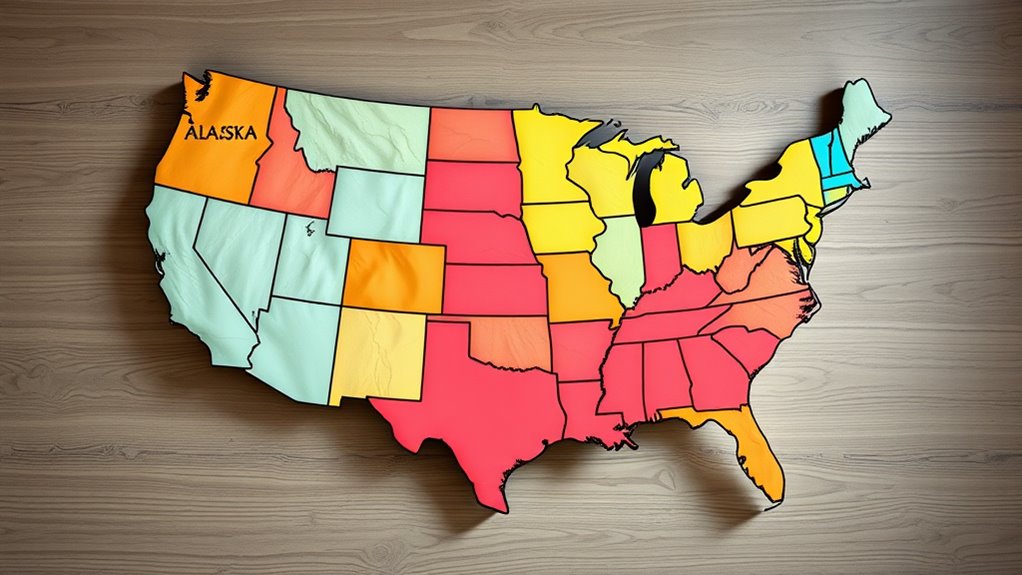Seven states—Alaska, Florida, Nevada, South Dakota, Tennessee, Texas, and Wyoming—don’t impose a state income tax. While this can reduce your tax burden, these states often offset this through higher sales or property taxes. For example, Tennessee has high sales taxes, and Alaska relies on oil revenues. Consider how these trade-offs align with your financial goals. Exploring further will uncover detailed insights into each state’s unique tax structure and economic landscape.
Key Takeaways
- Seven states have no state income tax: Alaska, Florida, Nevada, South Dakota, Tennessee, Texas, and Wyoming.
- No-income-tax states often rely on higher sales, property, or excise taxes to offset lost revenue.
- Alaska has the lowest total tax burden at 4.93%, supported by oil revenues and the Alaska Permanent Fund.
- Nevada’s high sales taxes and gaming industry revenues contribute to its 7.37% total tax burden.
- Tennessee and Florida have high combined sales tax rates, impacting overall affordability for residents.
Overview of States With No Income Tax
While some states rely heavily on income taxes to generate revenue, seven states—Alaska, Florida, Nevada, South Dakota, Tennessee, Texas, and Wyoming—don’t levy a state income tax. However, living in states with no income tax doesn’t mean you’re exempt from other taxes. These states often offset the lack of income tax by imposing higher sales taxes or property taxes to fund essential services. For example, Alaska has the lowest total tax burden at 4.93%, partly due to oil and gas revenues, while Florida’s tax burden of 6.05% results from higher sales and excise taxes. Nevada, with a 7.37% tax burden, relies heavily on sales taxes and gaming industry revenues. South Dakota’s 6.44% tax burden is sustained by taxes on items like cigarettes and alcohol. Additionally, New Hampshire, which taxes only investment income, is phasing out such taxes by 2027. Your overall tax burden in these states will depend on how these alternative taxes impact your finances.
Key Considerations Before Moving
Before deciding to move to a state with no income tax, you’ll want to weigh the broader tax landscape and how it aligns with your financial situation. While you may benefit from lower or no income tax, you could face higher sales taxes or elevated property tax rates, which could offset your savings. For example, Tennessee’s combined sales tax rate is one of the highest in the nation at 9.548%. Additionally, you should consider the affordability of living costs, as they can vary widely between states. Public services, such as education and infrastructure, may also be funded differently, potentially impacting the quality of life. Examine the overall tax burden, including excise and other levies, to determine true affordability. Finally, stay informed about potential tax implications from legislative changes, as states may adjust their tax systems, affecting your long-term financial outlook.
Comparison of States With No Income Tax

How do states with no income tax differ in their tax structures? They rely on alternative revenue sources such as sales tax rates, property taxes, and other levies. For instance, Tennessee compensates for its lack of income tax with one of the nation’s highest sales tax rates, while Florida offsets its policy through higher sales tax and excise taxes. Alaska, however, stands out by forgoing a state sales tax entirely and distributing funds from the Alaska Permanent Fund, a revenue model unique to the state. New Hampshire, unlike other states without income tax, doesn’t tax earned income but imposes an investment income tax instead. These diverse approaches highlight how states adapt their tax structures to maintain state revenue. While all states without income tax avoid taxing personal earnings, their reliance on higher sales tax, property taxes, or alternative levies creates distinct financial landscapes for residents.
 State-Specific Details: Alaska and Florida
State-Specific Details: Alaska and Florida
Although Alaska and Florida both operate without a state income tax, they’ve developed distinct approaches to revenue generation. Alaska leverages its oil revenues to fund public services, which also allows residents to receive annual payments from the Alaska Permanent Fund. Florida, on the other hand, relies heavily on its sales tax, making its total tax burden slightly higher at 6.05% compared to Alaska’s 4.93%. Here’s how these states differ:
- Healthcare Costs: Alaska faces high healthcare costs, while Florida, despite its popularity among retirees, struggles with affordability due to its sales tax structure.
- Education Spending: Alaska dedicates significant funds to education spending, whereas Florida ranks low in this area.
- Revenue Sources: Alaska benefits from its oil revenues, while Florida depends on its robust sales tax system.
- Tax Burdens: Alaska’s total tax burden is lower, but Florida’s sales tax can disproportionately affect lower-income residents.
These differences highlight how each state balances its financial needs without state income taxes.
State-Specific Details: Nevada and South Dakota

While Nevada and South Dakota both avoid imposing a state income tax, they’ve adopted different strategies to generate revenue and address public needs. Nevada relies heavily on high sales tax, sin taxes, and revenue from its thriving casino and hotel industry, resulting in a total tax burden of 7.37%. However, residents may face higher living costs and lower spending on public services like education and infrastructure. South Dakota, with a total tax burden of 6.44%, leans on high sales tax and excise taxes on cigarettes and alcohol to fund its operations. Its affordability ranks fifth among states with no income tax, offering residents a more favorable economic environment. Both states attract individuals seeking relief from direct taxation, but their approaches to funding public services and their impacts on living costs differ greatly. Your choice between them may depend on how you weigh affordability against the quality of public services.
Conclusion
Choosing a state with no income tax is like steering through a financial river—each offers its own current and benefits. While the absence of state income tax may lighten your fiscal load, remember the broader landscape: property taxes, cost of living, and public services. Carefully weigh these factors to guarantee your choice aligns with your financial goals. By analyzing the details, you’ll find the right balance for your economic journey.




